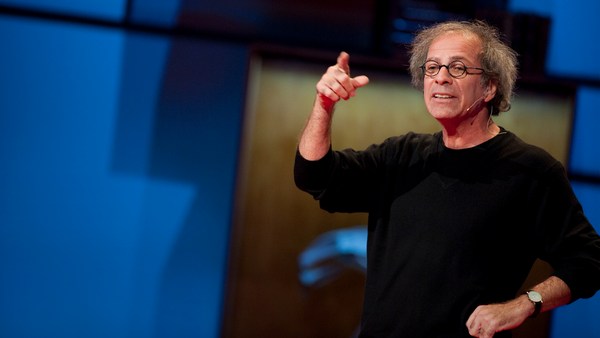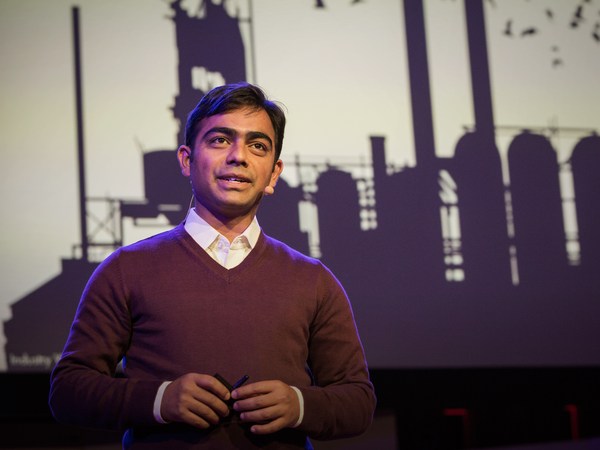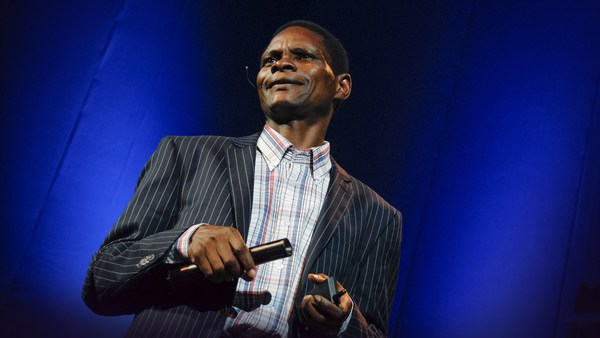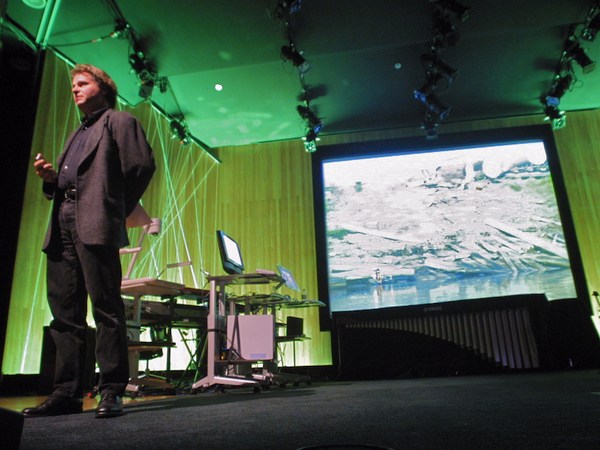I'm going to talk about some of my discoveries around the world through my work. These are not discoveries of planets or new technologies or science. They're discoveries of people and the way people are, and new leadership.
This is Benki. Benki is a leader of the Ashaninka Nation. His people live in Brazil and in Peru. Benki comes from a village so remote up in the Amazon that to get there, either you have to fly and land on water, or go by canoe for several days. I met Benki three years ago in Sao Paulo when I'd brought him and other leaders from indigenous peoples to meet with me and leaders from around the world, because we wanted to learn from each other. We wanted to share our stories with each other.
The Ashaninka people are known throughout South America for their dignity, their spirit and their resistance, starting with the Incas and continuing through the 19th century with the rubber tappers. Today's biggest threat to the Ashaninka people and to Benki comes from illegal logging -- the people who come into the beautiful forest and cut down ancient mahogany trees, float them down the river to world markets. Benki knew this. He could see what was happening to his forest, to his environment, because he was taken under his grandfather's wing when he was only two years old to begin to learn about the forest and the way of life of his people. His grandfather died when he was only 10. And at that young age, 10 years old, Benki became the paje of his community. Now, in the Ashaninka tradition and culture, the paje is the most important person in the community. This is the person who contains within him all the knowledge, all the wisdom of centuries and centuries of life, and not just about his people, but about everything that his people's survival depended on: the trees, the birds, the water, the soil, the forest. So when he was only 10 and he became the paje, he began to lead his people. He began to talk to them about the forest that they needed to protect, the way of life they needed to nurture. He explained to them that it was not a question of survival of the fittest; it was a question of understanding what they needed to survive and to protect that.
Eight years later, when he was a young man of 18, Benki left the forest for the first time. He went 3,000 miles on an odyssey to Rio to the Earth Summit to tell the world what was happening in his tiny, little corner. And he went because he hoped the world would listen. Some did, not everybody. But if you can imagine this young man with his headdress and his flowing robe, learning a new language, Portuguese, not to mention English, going to Rio, building a bridge to reach out to people he'd never met before -- a pretty hostile world. But he wasn't dismayed.
Benki came back to his village full of ideas -- new technologies, new research, new ways of understanding what was going on. Since that time, he's continued to work with his people, and not only the Ashaninka Nation, but all the peoples of the Amazon and beyond. He's built schools to teach children to care for the forest. Together, he's led the reforestation of over 25 percent of the land that had been destroyed by the loggers. He's created a cooperative to help people diversify their livelihoods. And he's brought the internet and satellite technology to the forest -- both so that people themselves could monitor the deforestation, but also that he could speak from the forest to the rest of the world. If you were to meet Benki and ask him, "Why are you doing this? Why are you putting yourself at risk? Why are you making yourself vulnerable to what is often a hostile world?" he would tell you, as he told me, "I asked myself," he said, "What did my grandparents and my great-grandparents do to protect the forest for me? And what am I doing?"
So when I think of that, I wonder what our grandchildren and our great-grandchildren, when they ask themselves that question, I wonder how they will answer. For me, the world is veering towards a future we don't much want when we really think about it deep inside. It's a future we don't know the details of, but it's a future that has signs, just like Benki saw the signs around him. We know we are running out of what we need. We're running out of fresh water. We're running out of fossil fuels. We're running out of land. We know climate change is going to affect all of us. We don't know how, but we know it will. And we know that there will be more of us than ever before -- five times as many people in 40 years than 60 years ago. We are running out of what we need. And we also know that the world has changed in other ways, that since 1960 there are one-third as many new countries that exist as independent entities on the planet. Egos, systems of government -- figuring it out -- massive change. And in addition to that, we know that five other really big countries are going to have a say in the future, a say we haven't even really started to hear yet -- China, India, Russia, South Africa and Benki's own Brazil, where Benki got his civil rights only in the 1988 constitution.
But you know all that. You know more than Benki knew when he left his forest and went 3,000 miles. You also know that we can't just keep doing what we've always done, because we'll get the results we've always gotten. And this reminds me of something I understand Lord Salisbury said to Queen Victoria over a hundred years ago, when she was pressing him, "Please change." He said, "Change? Why change? Things are bad enough as they are." We have to change. It's imperative to me, when I look around the world, that we need to change ourselves. We need new models of what it means to be a leader. We need new models of being a leader and a human in the world.
I started life as a banker. Now I don't admit to that to anybody but my very close friends. But for the past eight years, I've done something completely different. My work has taken me around the world, where I've had the real privilege of meeting people like Benki and many others who are making change happen in their communities -- people who see the world differently, who are asking different questions, who have different answers, who understand the filters that they wear when they go out into the world.
This is Sanghamitra. Sanghamitra comes from Bangalore. I met Sanghamitra eight years ago when I was in Bangalore organizing a workshop with leaders of different NGO's working in some of the hardest aspects of society. Sanghamitra didn't start life as a leader of an NGO, she started her career as university professor, teaching English literature. But she realized that she was much too detached from the world doing that. She loved it, but she was too detached. And so in 1993, a long time ago, she decided to start a new organization called Samraksha focused on one of the hardest areas, one of the hardest issues in India -- anywhere in the world at the time -- HIV/AIDS. Since that time, Samraksha has grown from strength to strength and is now one of the leading health NGO's in India. But if you just think about the state of the world and knowledge of HIV/AIDS in 1993 -- in India at that time it was skyrocketing and nobody understood why, and everyone was actually very, very afraid. Today there are still three million HIV-positive people in India. That's the second largest population in the world.
When I asked Sanghamitra, "How did you get from English literature to HIV/AIDS?" not an obvious path, she said to me, "It's all connected. Literature makes one sensitive, sensitive to people, to their dreams and to their ideas." Since that time, under her leadership, Samraksha has been a pioneer in all fields related to HIV/AIDS. They have respite homes, the first, the first care centers, the first counseling services -- and not just in urban, 7-million-population Bangalore, but in the hardest to reach villages in the state of Karnataka. Even that wasn't enough. She wanted to change policy at the government level. 10 of their programs that she pioneered are now government policy and funded by the government. They take care of 20,000-odd people today in over 1,000 villages around Karnataka.
She works with people like Murali Krishna. Murali Krishna comes from one of those villages. He lost his wife to AIDS a couple of years ago, and he's HIV-positive. But he saw the work, the care, the compassion that Sanghamitra and her team brought to the village, and he wanted to be part of it. He's a Leaders' Quest fellow, and that helps him with his work. They've pioneered a different approach to villages. Instead of handing out information in pamphlets, as is so often the case, they bring theater troupes, songs, music, dance. And they sit around, and they talk about dreams.
Sanghamitra told me just last week -- she had just come back from two weeks in the villages, and she had a real breakthrough. They were sitting in a circle, talking about the dreams for the village. And the young women in the village spoke up and said, "We've changed our dream. Our dream is for our partners, our husbands, not to be given to us because of a horoscope, but to be given to us because they've been tested for HIV." If you are lucky enough to meet Sanghamitra and ask her why and how, how have you achieved so much? She would look at you and very quietly, very softly say, "It just happened. It's the spirit inside."
This is Dr. Fan Jianchuan. Jianchuan comes from Sichuan Province in southwest China. He was born in 1957, and you can imagine what his childhood looked like and felt like, and what his life has been like over the last 50 tumultuous years. He's been a soldier, a teacher, a politician, a vice-mayor and a business man. But if you sat down and asked him, "Who are you really, and what do you do?" He would tell you, "I'm a collector, and I curate a museum." I was lucky; I had heard about him for years, and I finally met him earlier this year at his museum in Chengdu.
He's been a collector all of his life, starting when he was four or five in the early 1960's. Now, just think of the early 1960's in China. Over a lifetime, through everything, through the Cultural Revolution and everything afterward, he's kept collecting, so that he now has over eight million pieces in his museums documenting contemporary Chinese history. These are pieces that you won't find anywhere else in the world, in part because they document parts of history Chinese choose to forget. For example, he's got over one million pieces documenting the Sino-Japanese War, a war that's not talked about in China very much and whose heroes are not honored. Why did he do all this? Because he thought a nation should never repeat the mistakes of the past.
So, from commissioning slightly larger than life bronze statues of the heroes of the Sino-Japanese War, including those Chinese who then fought with each other and left mainland China to go to Taiwan, to commemorating all the unknown, ordinary soldiers who survived, by asking them to take prints of their hands, he is making sure -- one man is making sure -- that history is not forgotten. But it's not just Chinese heroes he cares about. This building contains the world's largest collection of documents and artifacts commemorating the U.S. role in fighting on the Chinese side in that long war -- the Flying Tigers. He has nine other buildings -- that are already open to the public -- filled to the rafters with artifacts documenting contemporary Chinese history. Two of the most sensitive buildings include a lifetime of collection about the Cultural Revolution, a period that actually most Chinese would prefer to forget. But he doesn't want his nation ever to forget.
These people inspire me, and they inspire me because they show us what is possible when you change the way you look at the world, change the way you look at your place in the world. They looked outside, and then they changed what was on the inside. They didn't go to business school. They didn't read a manual, "How to Be a Good Leader in 10 Easy Steps." But they have qualities we'd all recognize. They have drive, passion, commitment. They've gone away from what they did before, and they've gone to something they didn't know. They've tried to connect worlds they didn't know existed before. They've built bridges, and they've walked across them. They have a sense of the great arc of time and their tiny place in it. They know people have come before them and will follow them. And they know that they're part of a whole, that they depend on other people. It's not about them, they know that, but it has to start with them. And they have humility. It just happens.
But we know it doesn't just happen, don't we? We know it takes a lot to make it happen, and we know the direction the world is going in. So I think we need succession planning on a global basis. We can't wait for the next generation, the new joiners, to come in and learn how to be the good leaders we need. I think it has to start with us. And we know, just like they knew, how hard it is. But the good news is that we don't have to figure it out as we go along; we have models, we have examples, like Benki and Sanghamitra and Jianchuan. We can look at what they've done, if we look. We can learn from what they've learned. We can change the way we see ourselves in the world. And if we're lucky, we can change the way our great-grandchildren will answer Benki's question.
Thank you.
(Applause)





